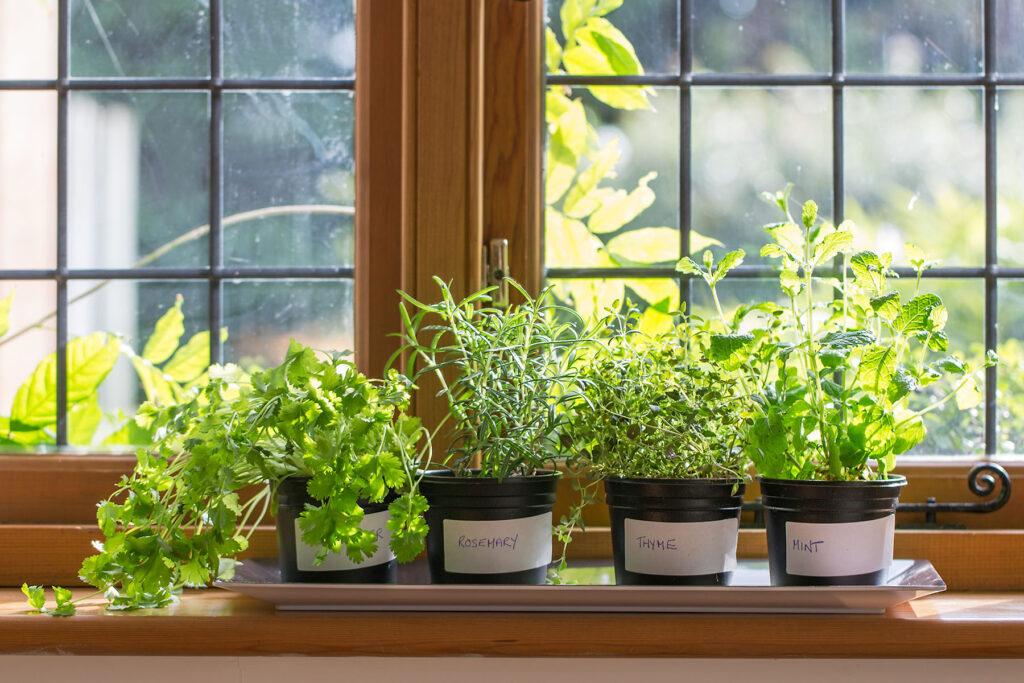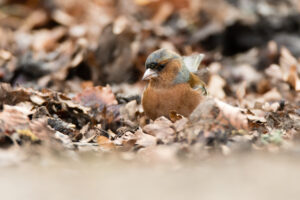As the seasons change from summer to fall and winter, you can still enjoy gardening indoors. Many gardeners love the convenience of having fresh herbs at home. What could be more convenient than having a few pots of herbs growing in your kitchen?
Growing herbs indoors is a great way to add fresh, yummy goodness to your meals in the winter. Many herbs are simple to grow. The most important thing you will need is a sunny window to set them nearby. Here are five (5) key things to know to grow your indoor herbs successfully.

1. What to Plant:
Not all plants are created equal; while most herbs can be grown indoors, some will be more successful than others. The herbs that will thrive for you are rosemary, thyme, oregano, basil, chives, mint, and parsley. Chives are great for cooking and add a pop of color to your windowsill with white and purple flowers. Fresh oregano is a hardy plant, great for beginners. It tastes milder than its dried counterpart. We recommend starting from seeds, this is typically the easiest route. Read the seed packet for germination times and growing instructions.
If you want to start from cuttings, you must make sure you begin sprouting them correctly, you have to cut at the node and soak in water until new roots begin to sprout. This can take a few days and be tricky if you have never done it.
When shopping for herbs, look for dwarf varieties or cool-weather herbs, as those typically require less sunlight.
2. Pick a Planter:
Once you decide on what herbs to plant, it’s time to start. Find a planter that offers good drainage. Pots with openings at the bottom and saucers under them are a great type of pot for your herbs.
Make sure to select the right size pot for your herb. Most herbs do well in smaller pots, like a 4” container. Shallow pots are best for herbs with shallow roots, such as chives, thyme, and oregano. For herbs like basil with longer roots, use a deeper pot.
When growing herbs indoors, it is better to grow one type of herb in one pot. Don’t try to combine multiple herbs in a single planter. You may find that one herb needs more sunlight or less water. Planting them separately will allow you to care for each plant individually.
3. Water Wisely:
You want to keep your plants wet but be careful not to overwater them. They should not be kept in standing water. Plants should have the opportunity to dry out between watering. Stick your finger into the soil to test the moisture. It is time to water if the top two inches of soil are dry. Like your lawn, you want your plant roots to grow deep, searching for water for a healthy root system. Consider watering two to three times per week. Daily watering is usually not necessary.
We have a wonderful indoor drip watering kit that can help you keep just the right amount of moisture in your plants. Check out the video below to see how easy it is to set up. Keep an eye on what you set the watering to. If your leaves start to turn yellow or look wilted, you are overwatering them. Turn the dial on the control unit to have the water run less often.
4. Find the Sun:
Find a place in your home where your herbs will be exposed to a good amount of sunlight – 6 hours of sunlight is the optimal amount to see your herbs thrive. Close to a window that is south-facing will be your best placement. In the winter there is naturally less sunlight; during this time, you may need to invest in a grow light or led light to lend some additional light to your growing herbs. You will notice your herbs are growing slowly or not at all, this is a good indication that they are not getting enough light.
Just like your veggies in your garden outside, indoor herbs prefer temperatures between 65-70 degrees. At night temperatures may drop by the windowsill, so make sure your windows are closed and consider adding insulation if there’s a draft.
5. Keep Growing:
Indoor herbs are not meant to last forever in these little pots. Eventually, they will outgrow their living space. If this happens, you can transplant them into a larger pot or outside, depending on the time of year. To ensure growth, don’t forget to fertilize regularly with plant food. Remember, bring them back inside when it gets cold. Herbs won’t survive frost.
Bonus hint: Regular cutback encourages new growth. Cut your herbs and enjoy them in your culinary creations. Happy growing!




